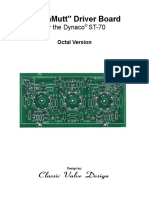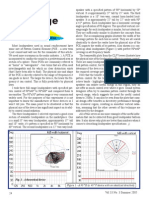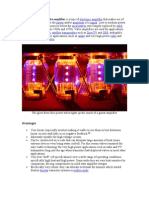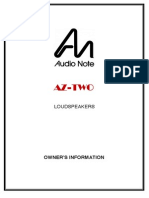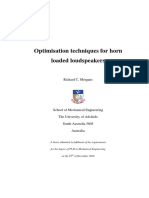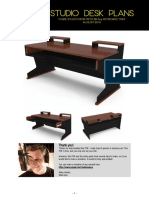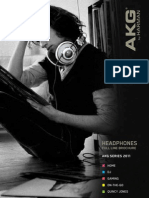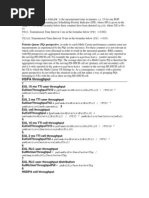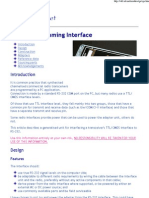Hiraga Onkens English PDF
Hiraga Onkens English PDF
Uploaded by
beepx1Copyright:
Available Formats
Hiraga Onkens English PDF
Hiraga Onkens English PDF
Uploaded by
beepx1Original Title
Copyright
Available Formats
Share this document
Did you find this document useful?
Is this content inappropriate?
Copyright:
Available Formats
Hiraga Onkens English PDF
Hiraga Onkens English PDF
Uploaded by
beepx1Copyright:
Available Formats
Making the Onken Enclosure, Jean Hiraga Audiophile No.
2, December 1977
Many Audiophiles are looking for "real" bass sound. To try to access it, all means have been implemented enclosures of large
size, multiple drivers , separate bass-amplification, active filters, EQ, Motional Feedback servoS. Others have preferred to
modify and improve the characteristics of the listening room, which is of course very important: arrangement of the
speakers, absorbers, selective reflectors in frequency, resonators to absorb multiple peaks and resonances. But "true" bass
sound not only mean objective quality being the result of well calculated enclosures.
This article will describe an ONKEN brand loudspeaker, reserved in Japan for a very demanding clientele. Studied around
1965, however, it was marketed, in very small quantities, in 1973. Large size (some 360 litres) it was a considerable success and
was used (and still is) as a reference system by a known Japanese magazine. In the October 1973 issue of Radio
Experimenter's Magazine, Mr Koizumi described it in all its details. Since then, many enthusiasts build it as well as several
loudspeaker manufacturers. In spite of the simplicity of this enclosure its realization requires good knowledge of carpentry!
There are about 4,500 to 5,000 speakers made by Japanese amateurs, certified copies of the Onken speaker. Given the zero
publicity of the firm Onken, it was really necessary that the results are exemplary so that many amateurs undertake its
realization. Because we should not forget that in Japan, the choice of Japanese speakers as imported is extremely broad and
allows for severe comparisons. If Onken's midrange speakers and tweeters are made "drop-in" Audiophiles de France will be
able experience the remarkable qualities of this enclosure, thanks to its easy realization and its affordability.
It is however understood that the bass speaker recommended here is not the Onken, but a model that brings, when mounted
in this chamber (an important point) very close results. This model, the ALTEC, model 416-8A was indeed the only speaker
giving close results, among many models tried.
Before proceeding to other details, it is recommend that Audiophiles eager to build this enclosure, respect all the details of
the realization and the dimensions of the enclosure. Even "recalculated", "enlarged" or "miniaturized" models have resulted in
failures in Japan.
Preliminary recommendations
This speaker is recommended for discerning Audiophiles dissatisfied with the quality of the bass sounds of their system.
Although many factors will affect the final quality of the bass, the important points to respect are: 1/ listening room of
acceptable dimensions, more than 4 x 6 m 2/ very rigid floor and well cushioned (double carpet). With these two conditions
respected, other points will play on the quality of the bass: tonearm , headshell , turntable-mat, to list the most sensitive.
ONKEN Enclosure: wood presses under ten tons
The original speaker ONKEN is very superior to imitations, even perfectly realized. This sensitive difference in listening seems
to come from wood. This 25mm thick plywood is specially made for Onken near Nagoya where the majority of furniture and
piano manufacturers are located. This wood, called either shinaban plywood or Canadian plywood has the particularity of
being not only very heavy, but to be composed of thin slats strongly hot folded, by ultrasonic process and then pressed by a
press of 10 tons. It should be noted here that before pressing each ply is strongly convex or concave and a/er pressing (hot) It
remains a constant thickness that gives high rigidity.
By hitting this type of plywood with a fingertip one notices a pure and clear sound. In general, it is rather either a dull or
"cracked" sound caused either by a press too light, or by a non-homogeneous bonding, or by a lack of glue. The quality of the
wood used is important for the 400-600 Hz sector, a difficult band to reproduce and located near the connection with the
midrange speaker.
Plywood used for ONKEN speakers. Strongly folded and curved and pressed with hot glue by a 10 ton press.
__________________________________________________________________________________ Onken Enclosure 1
Readers therefore need to find a very heavy and hard wood in this thickness. Let's add that using a lower quality wood of
double thickness does not really help. Wood of quality close to the one used on the Onken speakers can be found either in
Switzerland or at the manufacturers of small boats ( "marine" quality wood).
Felt
The 15mm felt used in the ONKEN enclosure is made of 100% pure wool and moderately pressed (medium density). In no
case should we use glass wool or a different amount of felt, chosen a er long tests and objective and subjective
measurements.
Manufacturing
The wood selected and found, it is always recommended to have it cut and glued by a well-equipped carpenter. The final
bonding of the six walls must be done precisely, and heavy clamped.
All cleats and anti-vibration reinforcements are screwed and glued , another point to respect. Note that the front panel is
removable and fixed by 16 screws (+ head) of length about 42 mm. In most cases, the tightening of these screws can not be
done by hand (use a t-bar driver or a speeder-handle).
The first part to make are the two side walls with vent ducts. The completed side parts are glued at once with the top,
bottom and back. Before this assembly note that cleats are screwed and glued which allows the screwing and gluing of the
back. The glue used is hot glue, used by carpenters. Synthetic rubber-based glue is not recommended here.
Note the presence of many reinforcements on most walls, which are all screwed and glued. The six walls are also screwed and
glued, taking care to hide the marks le by the screws on the outer walls. It can be used for this either special glue (very thick)
or a mixture of plaster and glue, which will be equalized a/er complete drying.
The finish of Onken speakers is made by a special paint applied in two parts. The first rendering a er drying the "cracked"
surface, thickness about 1 mm; the second is a spray paint, very dark gray, semi-mat. The front panel should not have a grill.
Another important point is to mount the speaker through the back of the cabinet and not fixed in front. Despite the many
theoretical disadvantages, the rear mounting is the one giving the best subjective results. Note that the baffle perforation, 34
cm in diameter, has been calculated for the best phase response and thus a disturbing part of the speaker's external
suspension is hidden.
__________________________________________________________________________________ Onken Enclosure 2
Fixing the speaker
The 416-8A loudspeaker basket, although imposing, must be attached carefully. This speaker is high efficiency and has a very
narrow air gap. The slightest deformation is enough to shi/ the frame / membrane assembly.
It is therefore necessary to screw very slowly and little by little each screw. One can also screw with baffle separated from the
ground by two cleats while injecting a sinusoidal signal of very low frequency, 5 to 10 Hz, at the limit of bottleneck.
If the generator can allow it, go lower in frequency (1 to 2 Hz) so that at these frequencies, inaudible, any decentering will be
felt. This setting must be done in total silence.
Layout of the reinforcements
The back side has a waterproof window, dimensions 6 x 10 cm on which will be fixed on the inside, a bakelite plate, thickness
1 cm. including the speaker terminals. Choose terminals of quality and generous dimensions. Those used on the Onken
enclosure have an outside diameter of 15 mm, length 3 cm.
Connect the terminals and the loudspeaker with quality wire, like "LUCAS", the one giving the best results here.
Speaker Break-in
If it poses environmental problems it is essential to get an early operation. Break-in mainly concerns the external suspension
and the centering spider, which must not be so loosened by hand.
Proceed as follows:
Inject at 0.6 watts the following signals:
25 Hz for 5 hours 110 Hz for 2 hours 1000 Hz for 2 hours 3,000 Hz for 1 hour
in the order above, repeat 4 times. This break-in is important and avoids the many adjustments and re-adjustments during
the following months.
Detail of panel cutting
Speaker Layout
Out from the back wall by at least 1 meter. Away from side walls by at least 1 meter. Placed directly on the ground or on a
stone base. Very demanding audiophiles can make polished granite slabs on 5 sides (edges + top) of dimensions 65 x 90 x 8
cm. Place hard felt (minimum thickness 5 mm) between the slab and the enclosure.
The minimum distance between the inner walls of the speakers is 1.80 m.
__________________________________________________________________________________ Onken Enclosure 3
Crossover Frequency
Most common is 600 Hz cutoff with 12 dB per octave. A quality active filter is advantageous, but it is possible use a passive
filter consisting of a 3m inductor, made of large diameter wire (3 to 3.5 mm in diameter as on the Onken filters) and a
capacitor with impregnated paper, quality, unpolarized, value 24 µF (or 2 capacitors of 12 µF mounted in parallel). Do not use
wound coils of sheet metal or ferrite core. Connect the filter elements with large wire diameter 3 mm.
Advantages of the ONKEN enclosure
It is always possible, by cone treatment for example, to make a loudspeaker mounted in an enclosure have a very linear
frequency. Unfortunately this is always at the expense of performance and definition.
The average efficiency of the Onken speaker is 96 dB per watt, about 10 dB more than conventional speakers. In the majority
of cases a power amplifier between 5 and 50 watts is largely sufficient. This speaker can accept 60 watts, its exceptional
performance translates acoustically to an intense level, difficult to live with, but not distorted. In comparison a low
performance speaker would require 3,000 watts to achieve the same level, which is technically impossible without destroying
the voice coil. This is more commonly reflected by saturation and limitations on musical peaks.
This speaker, mounted with the Altec 416-8A Speaker gives results very close to the original speaker Onken. For a level of 100
dB at 1 m, the distortion remains less than 0.8% at 35 Hz, 0.2% between 60 and 600 Hz . This performance is it difficult to
obtain at so low a cost.
Musical qualities
This speaker has been detailed in the Review of Sound (No. 275). The bass quality also depends on the quality of the
midrange and the treble, the bass sound of Onken speakers is characterized by great lightness, firmness and exceptional
dynamics.
Audiophiles who do not like large-diameter bass speakers must first of all consider that the most important thing in a
loudspeaker is not the mass of the diaphragm (very light in the case of 416-8A), but rather the ratio transmitted energy /
mass of the cone, which in this case is very high and plays a major role in the results.
The magnet used on the 416-8A is a central magnet, not a crown, which minimizes magnetic leakage (a piece of ferrous
metal does not "stick" to the magnetic circuit, despite the large total magnetic intensity and very generous air gap flow:
15,000 Gauss (1.5 Tesla) In most cases, not only is the membrane heavier, the magnet less powerful and the gap wider, but the
crown magnet introduces an inevitable magnetic leak, easy to demonstrate, this leak can reach 30% which further
aggravates the energy / mass ratio.
ONKEN SPEAKER FR CURVE, with Altec 416-8A
Note the exceptional performance (96 dB per watt on average) and the good linearity (35-1000 Hz ± 3.5 dB)
Even without causing too much coloration, a large mass driven by low energy makes the perfect control of the cone
impossible. By touching the stylus tip of the cartridge one can hear the bass speaker "beat" and "drag". If the acceleration is
easy, the reverse is less, because it is impossible to instantly stop a cone of 100 to 130 gr am with such a weak force. This
comes down to the relationship between the power of an engine and the mass of a car . On this point the 416-8A, which is
nothing new, combines the advantages of an ultra-powerful motor to a light and rigid cone.
__________________________________________________________________________________ Onken Enclosure 4
Equivalent Circuit of the Onken speaker. This system had been proposed before 1950 by Jensen. Very close to the "acoustic
line" or sees however, that despite its appearance, this speaker is not the type "Bass Reflex". This equivalent circuit is indeed a
damped low-pass filter and not a resonant circuit.
In the Onken, it does wonders: very frank attacks, perfect clarity at low or high level. Thus this speaker can simultaneously
reproduce several very different bass sounds: a very so/ and fuzzy bass (room, reverb, distance effect) on which can be
detached at the same time other bass bass sounds to the strings "torn", cello with all the richness of the resonances of the
body, the serious dry and percussive percussion, the jerky and intense breath of the exhaust of a tractor …
In general, even without noticing colouration defects in a large majority of speakers, it should be noted that there is still a
"similarity" more or less marked between several serious sounds reproduced , signs of another form of colouration which one
could call "colouration of musical expression".
Properly tuned this speaker, is, as it had been described in the article, able to remain completely absent on some programs not
containing serious bass, which may seem obvious but is hardly respected. When setting, it is recommended to start with
sound sources containing virtually no bass and adjust the level of the bass to the limit of perceptible. Without touching the
levels, we then pass the sounds of more and more serious cello, bass, bass drum, organ. This setting is tricky and needs to be
repeated several times, at medium level , leaving all tone controls in a linear position.
__________________________________________________________________________________ Onken Enclosure 5
Let's say that the system proposed here, for the bass, is not "a good speaker", but that it is certainly a faithful device, capable
of reproducing a great variety of serious sounds, with an astonishing freedom of expression .
Recently, the 416-8A loudspeaker has been replaced by the 416-8B, differing in its chassis and magnet. However, it is
recommended to buy the old version, the differences playing mostly on the extreme low (band 30-50 Hz). Thus proposed its
cost price is interesting given its performance, reduced cost price only to:
• Two Altec 416-8A speakers
• Six boards of 180 x 90 cm x 25 mm
• Pure wool felt
• Two 600 Hz 12 dB low pass filters
• and good ears for final tuning!
Hope that this enclosures will know deserved success in France.
__________________________________________________________________________________ Onken Enclosure 6
You might also like
- Lesson 1 - Introduction and Brief History of DanceDocument8 pagesLesson 1 - Introduction and Brief History of DanceSoojuu sojuu100% (4)
- Hornresp ManaualDocument161 pagesHornresp Manaualsakura 835No ratings yet
- Audioxpress 01 2023Document68 pagesAudioxpress 01 2023andree wNo ratings yet
- Looking Over My ShoulderDocument53 pagesLooking Over My ShouldertemplercNo ratings yet
- SCD-XE670 Service ManualDocument88 pagesSCD-XE670 Service ManualAnonymous saiA8njhtBNo ratings yet
- E170Document1 pageE170Bernard Kwabena AmeyawNo ratings yet
- Final Report (Speaker Design)Document22 pagesFinal Report (Speaker Design)sudhamshuNo ratings yet
- Gotham Audio 1979 CatalogDocument16 pagesGotham Audio 1979 CatalogkeenastNo ratings yet
- Voice of The TheatreDocument16 pagesVoice of The TheatreMario NấmNo ratings yet
- User Guide: Broskie Cathode FollowerDocument13 pagesUser Guide: Broskie Cathode Followerandree wNo ratings yet
- Keele (1981-05 AES Preprint) - Monitor Loudspeaker SystemsDocument21 pagesKeele (1981-05 AES Preprint) - Monitor Loudspeaker SystemsBob Beduneau100% (1)
- "Dynamutt" Driver Board: For The Dynaco St-70Document16 pages"Dynamutt" Driver Board: For The Dynaco St-70azornNo ratings yet
- Phono Cartridge AlignmentDocument59 pagesPhono Cartridge AlignmentLaurentiu Apostol100% (1)
- Review: Ming Da MC-2A3 Tube Preamp - Audiogon Discussion ForumDocument13 pagesReview: Ming Da MC-2A3 Tube Preamp - Audiogon Discussion Forumandree wNo ratings yet
- 1952 9 AudioDocument84 pages1952 9 Audiokimbalsummers801100% (1)
- QUAD QC-Twenty Four Brochure PDFDocument16 pagesQUAD QC-Twenty Four Brochure PDFTS LimNo ratings yet
- AudioXpress - February 2020Document68 pagesAudioXpress - February 2020Nicholas ThenNo ratings yet
- AudioXpress - January 2024 USDocument68 pagesAudioXpress - January 2024 USkgyjuhi100% (2)
- Tapered Quarter Wave TubeDocument7 pagesTapered Quarter Wave Tubegheo23No ratings yet
- C. Speakers and AmplifierDocument42 pagesC. Speakers and Amplifierfaytyf0812No ratings yet
- The Urei LA1ADocument3 pagesThe Urei LA1AAndresGelvezNo ratings yet
- Olson Direct Radiator Loudspeaker EnclosuresDocument5 pagesOlson Direct Radiator Loudspeaker Enclosureskorea12345fsfagvdsvNo ratings yet
- 6C33C-B OTL Amplifier - Background and OTL CircuitsDocument14 pages6C33C-B OTL Amplifier - Background and OTL Circuitsettorreit100% (1)
- Construction Article A Hi-Fi Vacuum Tube Phono PreampDocument18 pagesConstruction Article A Hi-Fi Vacuum Tube Phono PreampΔημητριος Σταθης100% (1)
- A 40Hz Bass HornDocument2 pagesA 40Hz Bass Hornszolid79No ratings yet
- Wharfedale HistoryDocument24 pagesWharfedale HistoryradovanovdNo ratings yet
- An LP Primer: How The LP WorksDocument4 pagesAn LP Primer: How The LP WorksAmir Sanjary ComposerNo ratings yet
- Cleaning Mic CapsulesDocument3 pagesCleaning Mic CapsulesLordENo ratings yet
- Keele (1974-04 AES PublishLow-Frequency Loudspeaker Assessment by Nearfield Sound-Pressure Measuremented) - Nearfield PaperDocument9 pagesKeele (1974-04 AES PublishLow-Frequency Loudspeaker Assessment by Nearfield Sound-Pressure Measuremented) - Nearfield PaperlaserzenNo ratings yet
- Analog Filter Design Demystified: The Theory of Analog ElectronicsDocument11 pagesAnalog Filter Design Demystified: The Theory of Analog ElectronicsSanjay Parelkar100% (1)
- Motional Feedback On A Loudspeaker WooferDocument122 pagesMotional Feedback On A Loudspeaker WooferValk1902No ratings yet
- Megalith Jean HiragaDocument5 pagesMegalith Jean HiragaTEDY-RNo ratings yet
- Part 1 Ovation Symphony Line Preamplifier V1.0 PDFDocument34 pagesPart 1 Ovation Symphony Line Preamplifier V1.0 PDFLuisAlejandroPardoNo ratings yet
- Beyma BookDocument91 pagesBeyma BookRajuNo ratings yet
- Jaes V52 5 All PDFDocument116 pagesJaes V52 5 All PDFtimosp1973No ratings yet
- Loudspeakers Coverage AnglesDocument0 pagesLoudspeakers Coverage AnglesAnthony HubbardNo ratings yet
- 07 - Selenium JBL Audio ReinforcementDocument8 pages07 - Selenium JBL Audio ReinforcementJose Rafael CentenoNo ratings yet
- Acoustic Lens Family1Document4 pagesAcoustic Lens Family1Roberto KielNo ratings yet
- Valve AmplifierDocument2 pagesValve AmplifierАлександар Ози ВуковићNo ratings yet
- A Look at The Yaqin MC100BDocument24 pagesA Look at The Yaqin MC100BRoi Rey100% (1)
- CQ 12 December 1946Document76 pagesCQ 12 December 1946Сергей БезразличныйNo ratings yet
- Quad II-40 ManualDocument14 pagesQuad II-40 ManualHorváth Andor0% (1)
- Decware Imperial S.ODocument5 pagesDecware Imperial S.OV Ger SevenNo ratings yet
- Em The Rem inDocument10 pagesEm The Rem injamato75No ratings yet
- Danley TappedDocument8 pagesDanley TappedmenombreesdanielNo ratings yet
- Diy Sony Vfet Amplifier Os2-1Document9 pagesDiy Sony Vfet Amplifier Os2-1alex_81_No ratings yet
- Optimisation Technics For Horn Loaded Speakers R.C.morgansDocument373 pagesOptimisation Technics For Horn Loaded Speakers R.C.morgansBob BeduneauNo ratings yet
- Types of EnclosuresDocument10 pagesTypes of EnclosuresTiến Nam Lê100% (1)
- Room Mode Calculator MetricDocument130 pagesRoom Mode Calculator Metricrun_d86No ratings yet
- Studio Desk Plans V2Document9 pagesStudio Desk Plans V2MIle MilicNo ratings yet
- A History of Kef Drive UnitsDocument15 pagesA History of Kef Drive UnitsDanteNo ratings yet
- AKG Brochure 2011Document68 pagesAKG Brochure 2011extiscalinetNo ratings yet
- HistoryDocument37 pagesHistoryHarneet SinghNo ratings yet
- Sony Philips Super Audio CD (SACD) White PaperDocument12 pagesSony Philips Super Audio CD (SACD) White PaperalancatsNo ratings yet
- QRDArrays Excel Calculator For Acoustic Diffusor BuildDocument20 pagesQRDArrays Excel Calculator For Acoustic Diffusor BuildJeremy Starseed100% (1)
- Digital Audio TechniquesDocument8 pagesDigital Audio Techniquesryanphs99No ratings yet
- Small Room Acoustics - The Hard CaseDocument8 pagesSmall Room Acoustics - The Hard CaseLeonardo De FinaNo ratings yet
- Mutual Coupling Between LoudspeakersDocument40 pagesMutual Coupling Between LoudspeakersDenys FormigaNo ratings yet
- Ongaku SchematicDocument1 pageOngaku Schematicbeepx1No ratings yet
- 2A3 Amp: I Never Met A That I Didn't LikeDocument7 pages2A3 Amp: I Never Met A That I Didn't Likebeepx1No ratings yet
- 300B Western Electric PDFDocument6 pages300B Western Electric PDFbeepx1No ratings yet
- We91a PDFDocument8 pagesWe91a PDFbeepx1100% (1)
- Dmtseries 1Document26 pagesDmtseries 1beepx1No ratings yet
- Affirmative Negative: Unit Subject Grade Teacher Date Name AimsDocument3 pagesAffirmative Negative: Unit Subject Grade Teacher Date Name AimsDaniel ReyesNo ratings yet
- Metti-Una-Sera-a-Cena Score PDFDocument10 pagesMetti-Una-Sera-a-Cena Score PDFDave ZedNo ratings yet
- Mahler Symphony 2 Low Brass ExcerptsDocument6 pagesMahler Symphony 2 Low Brass ExcerptsJavier Galindo CalvoNo ratings yet
- 359 - EC8651 Transmission Lines and RF Systems - Anna University 2017 Regulation SyllabusDocument2 pages359 - EC8651 Transmission Lines and RF Systems - Anna University 2017 Regulation SyllabuskiziNo ratings yet
- La Contessina - Blocco PartiDocument30 pagesLa Contessina - Blocco PartiFrancesco QuintoNo ratings yet
- Script Analysis For Staging Play Texts (Supplementary)Document34 pagesScript Analysis For Staging Play Texts (Supplementary)O-lan WangNo ratings yet
- JK PARAMPARYA - 02-08-21 Products1aDocument52 pagesJK PARAMPARYA - 02-08-21 Products1akailasamvvNo ratings yet
- B9-Organ Machine ManualDocument4 pagesB9-Organ Machine ManualYves DucastaingNo ratings yet
- Yanagita - Tono MonogatariDocument47 pagesYanagita - Tono MonogatariermauriNo ratings yet
- Hsdpa KPIDocument2 pagesHsdpa KPImikesul599No ratings yet
- A Practical Course in Mechanical Drawing PDFDocument168 pagesA Practical Course in Mechanical Drawing PDFДмитрий Бойко100% (1)
- Problems in Translation of Music Press HeadlinesDocument62 pagesProblems in Translation of Music Press HeadlinesmfiyzhNo ratings yet
- Rasafication: The Aesthetic Manipulation of Our EverydayDocument3 pagesRasafication: The Aesthetic Manipulation of Our EverydayHARINISRI V 21PHD1185No ratings yet
- Transponder Landing SystemDocument4 pagesTransponder Landing SystemWin Min100% (1)
- Midnights Song ReviewDocument2 pagesMidnights Song Reviewapi-548821680No ratings yet
- Samuel Andreyev: Assured and Permanent CatastropheDocument8 pagesSamuel Andreyev: Assured and Permanent CatastropheSamuel Andreyev100% (1)
- Journey To Unknown India by Walther EidlitzDocument111 pagesJourney To Unknown India by Walther EidlitzRandall G. Leighton0% (1)
- Iloy Namun Nga Bilidhon What Child Is ThisDocument2 pagesIloy Namun Nga Bilidhon What Child Is ThisCalib Omar Bartolome BacinilloNo ratings yet
- Cellular Wireless Networks 1Document64 pagesCellular Wireless Networks 1selemondoc100% (1)
- RadulescuDocument4 pagesRadulescubigbigbig90003270100% (1)
- All of Me SynthDocument4 pagesAll of Me Synthjcc292004No ratings yet
- Affinities Between Goethe's and Martin Buber's I To Thou OrientationDocument16 pagesAffinities Between Goethe's and Martin Buber's I To Thou OrientationJulian ScuttsNo ratings yet
- Modernisation of GMDSS-GOC Course and Examination Syllabus - DGS Circular 07 of 2024Document7 pagesModernisation of GMDSS-GOC Course and Examination Syllabus - DGS Circular 07 of 2024GavinNo ratings yet
- Enable Gnss RTK Anytime, AnywhereDocument3 pagesEnable Gnss RTK Anytime, AnywhereAlex TorresNo ratings yet
- Yishi Standalone Newest)Document4 pagesYishi Standalone Newest)Terry LamNo ratings yet
- Radio Programming InterfaceDocument9 pagesRadio Programming InterfaceNigel SalmonNo ratings yet
- Wwe Raw Script 28th November 2016Document3 pagesWwe Raw Script 28th November 2016chris wayNo ratings yet
- Production Log 2016-2017 Newer Doc (3) Includes Planning Review and Initial IdeasDocument26 pagesProduction Log 2016-2017 Newer Doc (3) Includes Planning Review and Initial IdeasA FryNo ratings yet
- Urban Expos 20 Syllabus SP13Document6 pagesUrban Expos 20 Syllabus SP13sohel07No ratings yet












